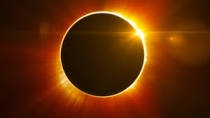
On Friday the 20th March there will be a total solar eclipse over Northern Hemisphere. The eclipse will be total over Norway and the Faroe Islands but there will be a 92% partial eclipse over Ireland. The eclipse will be visible from 8.30am in the morning, peaking at about 9.30 and complete by about 10.40.This is a fascinating and rare event to experience, however, we are advising members of the public to exercise caution in viewing the eclipse as prolonged exposure to direct rays of the sun can damage the retina by burning the delicate fovea, part of the light sensitive retina at the back of the eye. If this happens, vision is affected and can take up to a year for the fovea to heal, but in some cases there can be lasting damage. This is known as Solar Retinopathy.The safest way to view the eclipse is to make a small hole in a card and hold it up with your back to the sun and project the image of the sun on the ground or a second piece of white card. The eclipse will be clearly visible this way, though the image may be blurred around the edges. You must not view the sun directly through the hole.The eclipse can be safely viewed through appropriate filters called Eclipse glasses. It is essential that these glasses have no scratches or damage to the lenses. The glasses may be available through Astronomy clubs or on-line.High protection welding goggles are also suitable (filter 14 or over). These are not appropriate for viewing through telescope or binoculars.Sunglasses or 3D viewing glasses are not suitable and must not be used. A sharper image can be obtained by using a pair of binoculars. The binoculars must be set up on a stand or tripod, with the lenses directed at the sun and the eyepiece focussing on a piece of white card. This will give a sharp image of the eclipse. The sun must not be viewed through the binoculars or telescope directly under any circumstances.Remember to protect children who's eyes are even more suceptible to the damaging rays of the sun. Damage can occur in as little as 1 minute!


